-
DANSEUSE, LA/THE DANCER (Stéphanie Di Giusto 2016)
STÉPHANIE DI GIUSTO: LA DANSEUSE/THE DANCER (2016)
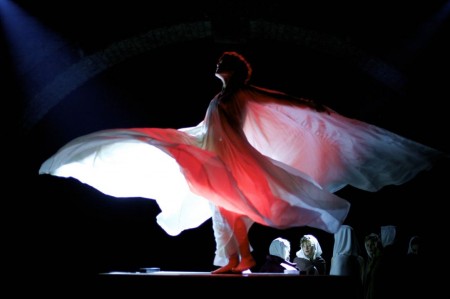
SOKO IN THE DANCER
Biopic of a turn-of-the-century dance innovator is showy, but fails to engage
Stéphanie Di Giusto's directorial debut is a lush but routine biopic. Its subject is a turn-of-the-century American dancer and theatrical staging pioneer known as Loïe Fuller, who took her talents to Paris. She wowed theatergoers with her dramatically swirled drapery and advanced use of mirrors and colored light. After a struggle for acceptance of her unusual routine, her talents were showcased at the Folies Bergère and briefly the Paris Opera. She helped other performers including the now more famous Isadora Duncan.
La danseuse begins with a long, unnecessary introduction depicting the protagonist's early life in America. This passage shows her past to have been exotic in French terms, with its trappings of a Western, her drunken father and bossy mother and her habit of carrying around a pistol. But none of this seems relevant later except to learn she was a child actress before conceiving more elaborate and unconventional performances and stagings.
As Fuller, we get the 100% commitment of Soko, who played the hypnosis subject of Alice Wincour's moody, stylized Augustine, with Vincent Lindon. Names in the cast include Gaspard Ulliel as the decadent Conte d'Orsay (an invented character, with him playing a less interesting version of his Saint Laurent lead),Mélanie Thierry as the dancer's beautiful manager, collaborator and lover Gabrielle Bloch; François Damiens as director of the Folies Bergère, Louis-Do de Lencquesaing as the Paris Opera boss, Christopher Plummer's daughter Amanda as Fuller's temperance crusader mother, and Johnny Depp and Vanessa Paridis's daughter Lily-Rose Depp as Isadora Duncan. The Conte d'Orsay is Fuller's involuntary Maecenas and would-be lover, who's hooked on ether, a period drug in this very period movie. Fuller flourished in the Nineties and early twentieth century. Perhaps the greatest success of this ho-hum effort is the way it evokes the tastes of its times - for such things as this cloth-swirling show, and for young women in diaphanous, vaguely classical drapery running around in the woods.
Di Giusto's film, written in collaboration with Jacques Audiard's writer Thomas Bidegain, takes various liberties, jazzing up lesbian relationships, adding a fictitious character in the Count, and dwelling so much on Loïe's muscle pains and eye trouble she comes to seem as much a patient as a performer. Swirling the gauzy materials around is shown to be a huge physical effort, sometimes leading to exhaustion. It hurts! What's wrong with her eyes - severely damaged apparently by the bright lights? We never really learn, but she spends the last third of the labored film putting in eye drops and wearing round sunglasses. Isabella Duncan, with Lily-Rose Depp lacking the authority to play such a future diva, is presented ambiguously. At some moments it seems we're supposed to hate her for seeming about to steal Loïe Fuller's fire. At others they seem not only friendly collaborators but erstwhile lesbian lovers. Loïe's off-and-on affair with the Conte d'Orsay has been strenuously criticized in queer circles for falsifying by diluting her pioneering open homosexuality.
Loïe's personality is otherwise unclear, seen as a mix of fiercely ambitious, physically determined, and insecure. She keeps saying she is not a dancer. And indeed her "flame" performance, in once scene impressively recreated here, is more playing with cloth and lightening than dancing in the classical sense. With all the effort, suffering, mood swings, and physical problems, Loïe Fuller still doesn't quite emerge as a real person. Even the final sequence, a fraught long-awaited debut at the Paris Opera, is ambiguous. It seems Loïe is barely able to go on, and as staged her performance, all in white instead of with the colors, seems lackluster, a disaster ending in collapse. Then she goes out to receive a standing ovation. Maybe that's how it actually was. But despite the impressive mise-en-scène, cast dotted with notables, and collaboration in the writing from Thomas Bideguin, Di Giusto has not produced a coherent or solidly enjoyable film.
The Dancer/La danseuse, 109 mins., debuted at Cannes may 2016; over a dozen other festivals, including the Rendez-Vous with French Cinema of FSLC and UniFrance (1-12 Mar. 2017), as part of which it was screened for this review. The French theatrical release 28 Sept. 2016 led to mixed reviews (AlloCiné press rating a fair 3.4). Most critics admired the dedicated performance of Soko; some noted the biopic conventionality.
Last edited by Chris Knipp; 02-17-2017 at 04:54 PM.
-
IN BED WITH VICTORIA/VICTORIA (Justine Triet 2016)
JUSTINE TRIET: VICTORIA/IN BED WITH VICTORIA (2016)

VIRGINIE EFIRA AND VINCENT LACOSTE IN VICTORIA
A hectic blonde lawyer
Victoria, with the delicious and amusing Virginie Efira in the lead role and featuring Vincent Lacoste and Melvil Poupaud, is a distinctive modern French version of a Hollywood screwball comedy, and the second film of Justine Triet, whose debut was the tour-de-force The Age of Panic/La bataille de Solferino (Rendez-Vous 2014). Its lead character is Victoria Spick, a divorcee with two young daughters whose career as a trial lawyer is highly accomplished but whose personal life is a trainwreck. And this has been compared to the recent Judd Apatow/Amy Schumer vehicle of that name. While Efira's talents may not match Schumer's, she's got them; and she and the other leads contribute to the fun by freely improvising. The jazzed-up English "in bed" title misleads a bit. Victoria keeps arranging online hookups for herself at her apartment, but she never manages to be in the mood.
The movie is perhaps most hilarious at the outset, during a chaotic, also American style, wedding party, but the trial that's the action's main focus has its moments too, even when a Dalmatian and a chimp are introduced in the elegant red courtroom as witnesses. Vincent Lacoste (if memories of him in Julie Delpy's crude Lolo don't kill him for you) plays a charmingly silly yet sincere and helpful young man ripe to become this lighthearted film's love interest. Victoria got Sam Mallet (Lacoste) off a drug dealing charge; they meet up again at the wedding. Out of work (without the drugs) and in effect homeless, he wants to be her law trainee and, to solve his residential problem, act as her au pair babysitter. Later he wants to be her lover, and this affectionate and more sincere hookup may solve her midlife sex crisis.
Vincent (the ever-watchable Melvil Poupaud), a dear friend of Victoria's, does a song and dance number at the wedding, a wonderful quick mix of modesty, ease and charm. Good and drunk, he tries to have sex at the party with his nutty ex, with her pet Dalmatian watching disapprovingly. (We don't see this.) She then accuses him of stabbing her in the stomach. (He says she stabbed herself: we don't see this.) He is arrested, and he insists Victoria defend him (we see this). She protests that mixing the personal with her criminal defenses is a big mistake, but gives in. Scenes at her sublimely chaotic apartment (thanks to production designer Olivier Meidinger) show the amiable disorder of her home life. (The two girls are charmingly and sparingly used.) When her ex, David (Laurent Poitrenaux), turns up uninvited, he reveals that he's writing a blog now that's a big hit due to its thinly disguised details of her professional and personal peccadilloes, including sex with judges (back in the day when she was up for sex, evidently). This leads to another court case, since his revelations threaten her career. A narcissistic nincompoop, he conducts his own defense.
Vicky's periodic arranged assignations at home only lead to confusion or nerves. Once an abandoned session gives her a serious anxiety attack and Sam, experienced at helping clients through bad trips, coaches her back to calm. He administers a Xanax, and she dozes. Her sleeping beauty is what enamors Sam and makes him want to kiss her. Meanwhile she sees not only a (white male) "psy," a shrink, but a large black female psychic who card-reads her fortune, usually disapprovingly. This mélange, when shown in rapid succession, produces a quietly giddy state of amusement in the sympathetic viewer - who, however, may be surprised when Vicky is summoned before the bar council for talking to a witness in a case. It was a woman who came to her home and harassed her: she should have refused to speak. Despite a beautiful lawyer's pleading in her defense, she gets suspended, like Will Gardner (Josh Charles) in "The Good Wife," but for a lesser offense and only for six months.
This leads her to let Sam go, but the girls will miss him and he will be in the wings ready to return when her suspension ends - and Vincent begs her to take his case again now that an old girlfriend (Claire Burger) has appeared, inspired by word of his impending trial, to accuse him of harassment. She will take the case on, with little time to prepare, and Sam will be back to become her lover and law assistant as well as man slave. The trial will climax with its Dalmatian-chimp appearances and a favorable outcome for Vincent and Vicky. But despite all the action this movie, which is glossier but obviously less original than La bataille de Solferino, isn't so much notable for its plot drive as for its comic vignettes, like Victoria's failed at-home sex hookups, Poupaud's song and dance performance, the meetings with Sam, the shrink and card-reader sessions. Triet manages to be both over-the-top and tastefully French - and sexy, especially in one heavy makeout scene between Lacoste and Efira (who throughout play very well together). It is this mixture that, especially if you're a fan of French film comedy, that will endear Victoria to you.
Victoria/In Bed with Victoria, 90 mins., debuted at Cannes May 2016 and opened in French cinemas 14 Sept. to great reviews (AlloCiné press 4.0) including a rare rave from Les Inrockuptibles and a favorable opinion from Cahiers du Cinéma. French critics more than once mentioned Woody Allen, and so does the American Jordan Mintzer of Hollywood Reporter, who locates Triet's comedy "somewhere between more femme-centric Woody Allen films like Alice or Another Woman and the work of French farce maven Louis de Funes." Shown at a dozen or so other festivals including Chicago and Vienna. Screened for this review as part of the 1-12 Mar. 2017 UniFrance-Film Society of Lincoln Center series The Rendez-Vous with French Cinema.
Saturday, March 4, 9:30pm (Q&A with Justine Triet)
Sunday, March 12, 3:30pm
Last edited by Chris Knipp; 12-05-2018 at 07:23 PM.
-
MA LOUTE/SLACK BAY (Bruno Dumont 2016)
BRUNO DUMONT: MA LOUTE/SLACK BAY (2016)
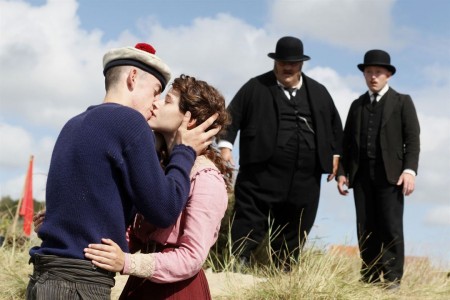
BRANDON LAVIEVILLE, RAPH, DIDIER DESPRES, CYRIL RIGAUX
A post-Victorian slapstick murder mystery by the sea takes Bruno Dumont in a new even stranger direction
In Ma Loute/Slack Bay, one of the weirdest and most arresting movies you may ever see, the Bruforts are a family of rude sailors who carry softer folks across a shallow bay in their arms. They also practice cannibalism, and that explains the disappearance of a young couple from Lille. This event is being vaguely investigated by inspectors Machin and Malfoy (Didier Després, Chril Rigaud), a Laurel and Hardy-like pair. The Bruforts' eldest son, an angular rube called Ma Loute (Brandon Lavieville), connects with the daughter - or is it the son? - Billie (Raph) of the haughty Van Peteghem family, who have come to their Egyptian-style manse on the hill for the summer. This might be a love that would cross the class divide, and the sexual one too, since "ma loute" is a feminine term of endearment - but instead it goes bad. The action is set in the early days of automobiles, in 1910, by the sea, near Dumont's usual rather desolate home region of Bailleul, Nord, but we're far from the harsh, intense neorealism of his early films if not from their religious overtones.
An extension in a way of his 2014 mini-series P'tit Quinquin/L'il Quinquin, which also has a pair of bumpkin cops investigating a chain of murders, this is stranger and harder to relate to. It's a costume drama, with elaborate, melodramatic, absurd acting mannerisms. It also has two more name actors. Valeria Bruni Tedeschi and Fabrice Lucchini join Juliette Binoche, who was there last time. All behave and look peculiar. In the case of Binoche, as Aude Van Peteghem, this is allowed to go much too far: she croons and moans - it's just bad overacting. Lucchini, as André Van Peteghem, comes off better. He is almost unrecognizable, his face looking flat and a little bloated; almost a hunchback, he lurches back and forth, his arms flailing oddly. Brother Christian (Jean-Luc Vincent, Paul Claudel in Dumont's 2013 Camille Claudel) is similar. Everyone tends to fall down a lot. So does the big, bloated Inspector Machin, who rolls down sand dunes and topples into things constantly. Does all this ineptness, these pratfalls, make this a comedy? But what about the cannibalism?
Dumont is always unclassifiable. Hence it should not surprise us that he was meaning here to evoke the haute-bourgeoisie charm of the photographs of Jacques Henri Lartigue (at least in his detailed article on the making of the film in Le Monde, Jacques Mandelbaum says so). Or that there is an interrupted outdoor ceremony in celebration of the Virgin Mary that leads Aude to float up into the air, which happens to Machin in the final sequence, when he inflates even more, and breaks away from a rope. Magic realism, surrealism, horror, harsh social satire, slapstick, black Charles Addams comedy form a mixture that is both numbing and hypnotic.
This personal world is rich and fascinating in its way. And it's beautiful: look at the delicate color, and the lovely decor of the Van Peteghem dining room. Watch the romantic, painterly scene of small boats on a stormy sea and listen to the soaring music of Bach at the end. And yet the action lacks the charm of L'il Quinquin or the power of Dumont's strong earlier films. Here, he has lined up two class enemies, a "decadent bourgeoisie and carnivorous proletariat," as Philippe Lagouche of La Voix du Nord put it, in a "ferocious farce" that "Buñuel would have loved."
With the exception of the misfired US-set Twentynine Palms, Dumont made one stunner after another: Life of Jesus, Hunanité, Hadewijch (NYFF 2009) and Hors Satan command one's utmost attention, almost reverence, even if one is at times also repulsed. Well, Slack Bay/Ma Loute too provides a bracing, unique experience. But Dumont seems to have entered a mannerist phase.
Ma Loute/Slack Bay,122 mins., debuted at Cannes in Competition May 2016 and opened in French cinemas simultaneously, to rave reviews (AlloCiné press raging 4.1)
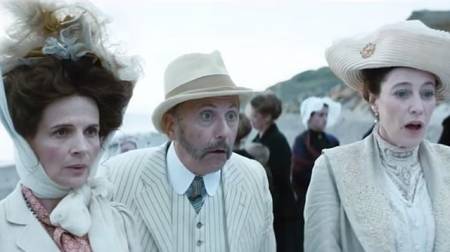
BINOCHE, LUCCHINI, BRUNO TEDESCHI
Ma loute/Slack Bay, 122 mins., debuted at Cannes in Competition May 2016 and opened in French cinemas simultaneously, to rave reviews (AlloCiné press raging 4.1). Screened for this review in Rendez-Vous with French Cinema (UniFrance, Film Society of Lincoln Center) Feb. 2017. US theatrical release begins 21 Apr. 2017. A Kino Lorber release.
Last edited by Chris Knipp; 06-18-2017 at 02:02 PM.
-
L'ODYSSÉE/THE ODYSSEY (Jérôme Salle 2016)
JÉRÔME SALLE: L'ODYSSÉE/THE ODYSSEY (2016)

LAMBERT WILSON AND PIERRE NINEY IN L'ODYSSÉE
Shallow waters
This biopic follows the career of the famous French undersea explorer and maker of TV documentaries Jacques-Yves Cousteau. He was a pioneer who made the world of water his domain. Commander Cousteau (Lambert Wilson), depicted here with his two sons Jean-Michel (Benjamin Lavernhe) and Philippe (Pierre Niney) and his wife Simone (Audrey Tautou), was a naval officer, member of the Académie Française, scientist, innovator (most notably of the aqualung), explorer, conservationist and indefatigable public figure as well known in America and beyond as in his native France. Salle has made a grand and glorious film full of energy and hope and enlivened by big, bright, open images of sun and sea, with some breathtaking underwater photography. The cinematography by Matias Boucard is luminous, the music by Alexandre Desplat sweeping.
And yet this movie based on books by Jean-Michel and Albert Falco takes on a routine air early on and winds up being at times on the flat and disappointing side, too timid in its exploration of rough truths, too hagiographic all the rest of the time. Salle's handsome, beautifully filmed movie has a few impressive diving sequences, but not many and only a couple that are awesome. But maybe that wasn't the point. Public issues and personal problems are not ignored. The trouble is that throughout, the film seems showy and artificial. It winds up feeling like a missed opportunity: too often the ceremonial overtakes the dramatic, and overall a bit on the bland side. Salle's Odyssey is a spectacle that will delight fans of ocean photography and of Cousteau. It's just not one of the year's compelling dramatic films.
The film doesn't hesitate to depict some of Cousteau's sad, dark times and conflicts with Simone and Philippe. Tautou and Niney shine, and this is further proof that Niney has the makings of a big star, who's perhaps at his most dashing and sexy on screen yet as Philippe. Philippe's conflict with his father began when the brothers were sent off to boarding school, which he considered "abandonment." It's clear the Commander has some large blind spots and a giant ego, and loves fame as much as he loves nature. Niney provides glamor and excitement as well as eye candy (the glowing skin, the sculptured torso, the glossy locks, the steamy glances), but the clash of father and son is powerful dramatic material that the film unfortunately only touches on.
There are important historical themes here. First of all Cousteau begins diving at a time when it was all new. He and his collaborators (a crew lovingly satirized in Wes Anderson's endearing The Life Aquatic with Steve Zissou <), with the big boat The Calypso, had to develop the aqualung, to breathe underwater, and the pressure-resistant cameras they used to photography the marvels they found. And then Cousteau had to develop a career - the big American contract to make films to be shown on TV. Over the decades, we see how this innovator started to become outmoded.
The height of Cousteau's fame comes through the Palme d'Or-awarded film (based on his first book), The Silent World, co-directed with Louis Malle; and then, starting in the Sixties, for decades the "Voyages of the Calypso" TV series was standard fare in the US and elsewhere.
The film gradually reveals the extreme naivety of the Calypso crew, who ignored how they were destroying the world they were observing. Cousteau is aware of ecological issues early on, but does work for petroleum interests because he needs financing - and that's an issue from the start, when Simone sells all her jewels to buy the Calypso. Later, the Commander forgets about ecology and cheats on his wife. This behavior causes a serious rift with Philippe, who disappears for four years - and Niney is missed. But they make up.
Fabien Lemercier comments on Cineuropa.org</a> that [i]L'Odyssée "doesn’t dig too deeply, so as to preserve the audiences’ empathy for its characters." That's precisely the trouble with this beautiful, ambitious, not unrealistic but still thoroughly timid movie. Commander Cousteau dives under the waters, director Salle stays on the surface.
L'Odyssée/The Odyssey, 122 mins., debuted 23 Aug. 2016 at the Festival du Film Francophone d'Angoulême, also showing at four other festivals, and released in French Cinemas 12 Oct. by Wild Bunch. French critical response was positive but not exceptional (AlloCiné press rating 3.4). Les Inrocks, Le Figaro, Libération, Le Nouvel Observateur, and Le Monde] all published reviews expressing serious disappointment. See the lively take-down in Le Nouvel Observateur and the explication of the more complex issues in LIbération. This film was originally screened in Paris in Oct. 2016, and again for the March 2017 FSLC/UniFrance Rendez-Vous with French Cinema, in New York.
-
L'OPÉRA/THE PARIS OPERA (Jean-Stéphane Bron 2017)
JEAN-STÉPHANE BRON: L'OPÉRA/THE PARIS OPERA (2017)
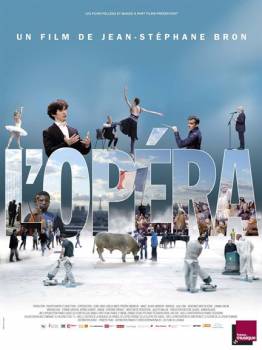
A distracted look at the Paris Opera
This Swiss/French documentary film, as the festival blurb says, "nimbly juggles a dizzying number of storylines," including strange staging of Schoenberg's Moses and Aron; bad press for the opera ballet director (who later resigned); a national strike that makes performances tricky;, the freshly hired young Russian bass-baritone Mikhail Timoshenko
- featured, understandably, in the trailer - he's photogenic and charming and could have been the subject of a documentary himself; a group of mostly black school kids who get several weeks of rehearsals of stringed instruments and a pubic performance attended by parents and a proud sponsor; an effort to replace a lead singer at the last minute; troubles with the blocking of a chorus; that chorus' director in action; some moments of ballet rehearsal; and on and on.
"Nibly" juggled, perhaps these various strains are. But there are too many of them. The director should have decided what he wanted to focus on. He seems too easily distracted, as for example, understandably, the director of the Opéra must give a speech after the November 2015 terrorist attacks. Since this film is meant to cover a single season and a half of the Paris Opera, and it included that time, reference to it needed to be there. But the details of using a giant bull in the staging of Moses and Aron is unnecessary. You have to ask yourself: was bringing this bull on the stage representative of the life of the Paris Opera? It just seems a novelty - and in the end how the bull appears in the finished production isn't even made clear. In fact, there is far too little footage of actual performances - the most essential, what this place is about, is badly underplayed. And some followups - the directorial resignation; how Mikhail Timoshenko's career has gone; he's been in many operas and recitals in he past couple years, the Opera's website shows, but he's left dangling by the distractible Blon.
Bron may feel he is doing something in the manner of Fred Wiseman, but he is not. He does not have Wiseman's dedication, thoroughness, and clarity. LOpeera doesn't hold up in comparison, in fact, with Wiseman's typically exhausting but highly rewarding 2009 documentary, La Danse: The Paris Opera Ballet. That film too, in rather more detail, includes a labor dispute. It also has lengthy, and illuminating, segments of dance practice. It concludes at the end of its nearly two and a half hours a satisfying view of the finished public performance of the ballet we've been seeing worked on. Wiseman proceeds methodically. He dots his i's and crosses his t's. He moves around, but everything he looks at, he looks at long.
In view of the fact that he doesn't do that, but prefers to flit about, Blon might have provided more guidelines to viewers, such as text lines identifying certain figures in the film when they first appear, and when they reappear after a long interruption. And he might have provided an introduction that informed non-French viewers what the Paris Opera is, that it has two venues, L'Opéra Garnier and l'Opéra Bastille, and might have clarified the film's movements back and forth between them. This film will show you glimpses of the wonderful stuff that goes on at this essential cultural venue. But as a documentary film, it falls a bit short.
L'Opéra/The Paris Opera, 110 mins., debuts in French cinemas 5 Apr. 2017, distributed by Les Films du Losange. Jean-Stephane Bron is a Swiss writer and director who has nine previous directorial credits, mostly documentaries. Not listed yet on IMDb, slated according to AlloCiné for French theatrical release 5 Apr. 2017. L'Opéra was screened for this review as part of the 1-12 Mar. 2017 Film Society of Lincoln Center-Unifrance series Rendez-Vous with French Cinema.
Thursday, March 2, 4:00pm
Saturday, March 11, 3:30pm
Last edited by Chris Knipp; 02-24-2017 at 09:10 AM.
-
LA FILLE DE BREST/150 MILLIGRAMS (Emanuelle Bercot 2016)
EMMANUELLE BERCOT: LA FILLE DE BREST/150 MILLIGRAMS (2016)
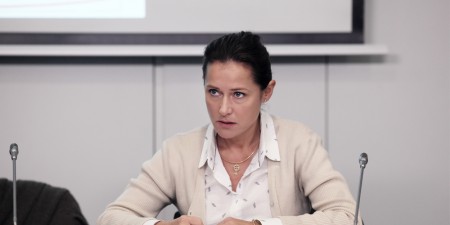
SIDSE BABETT KNUDSEN IN 150 MILLIGRAMS
A successful battle against French Big Pharma
Right after 2015's Standing Tall/La tête haute about an at-risk teenager who struggles to become a good citizen, actor-writer-director Emmanuelle Bercot has made an Erin Brockovitch/Karen Silkwood film about real-life big Pharma whistleblower Irène Frachon. In the role as the feisty "Brest Girl" is Danish-born actress Sidse Babett Knudsen, who's in every scene. Dr.Frachon is a pulmonologist at the university hospital in Brest, in Brittany. Assisting at an open heart surgery operation, she observes degenerated heart valves in a middle-aged woman, Corinne Zacharria (Isabelle de Hertogh), who's been taking the Sevier company's drug Mediator, prescribed for decades for diabetes and for weight loss. Frachon notices there are other similar cases. The film takes us through Frachon and her collaborators' struggle to get this killer drug taken off the market.
Bercot and her co-authors, adapting Frachon's own book Mediator 150 mg, Combien de morts? ("Mediator 150 mg., How Many Deaths?"), take us through grueling, sometimes numbing details of this struggle. This may seem a humorless film - except that Knudsen's slightly over-the-top performance is engaging and full of fun - and frankly I had doubts somewhere in the middle if all this mundane detail was really worth it. But at the end Irène Frachon's (and all her collaborators') victory feels so good, it all turns out to be worth it.
Essential to the process, and to the film, is the great Benoît Magimel - who won an award for his performance in Bercot's last film, who plays Dr. Antoine Le Bihan, a specialist in medical research, who authors a paper that is the basis for negotiations with authorities. Big Pharma is ruthless, of course, and indifferent. They don't care if hundreds are dying from Mediator; they just want to go on selling it for the hundreds of thousands of patients in the country taking it. Magimel's performance makes clear the human toll of this battle as Dr. Bihan is ruined by the drug company, losing all his grants, and eventually winds up applying for jobs in Canada. But this isn't just a movie of a few stars, great though the two leads are: it's an ensemble piece, and when the ministry makes its statement condemning Sevier and withdrawing Mediator from the market, the camera pans around to all the people who have played a role. Not least, Dr. Frachon's family, and her good-humored husband who, when she notices his new glasses, which he's been wearing for three months, just laughs, and is the one who persuades her not to give up at her lowest point.
The beauty of 150 Milligrams is in its meticulous details of every stage of the struggle, and that makes it hard to talk about. Early on, notably, Dr. Franchon loses her cool at her first hearing before the government review board and does what Bihan said she should absolutely not do. She reveals that there is a study under way, and that he heads it. This puts the under an almost impossible deadline. They must finish the study immediately. At the board, the Sevier officials are condescending and game the system skillfully to put off any enquiry. When she and her collaborators ever appear, they are mocked as being rubes because they're from Brittany and the small city of Brest. Later, not for the first time, Dr. Franchon is contacted by an insider, this time a man inside the national insurance system, which is penetrated by Big Pharma. He takes the code name Santa Claus ("Père Noël"), and is the one who can gather national statistics of the number of deaths attributable to the drug. Dr. Franchon also has a female PhD candidate who attaches herself to her, who even more skillfully and rapidly crunches numbers.
When they have suffered several defeats, rather in desperation Dr. Franchon writes the book, Mediator 150 mg with the subtitle Combien de morts?, How Many Deaths? The drug company brings suit against her tiny publisher (another ally gathered along the way) and bars him from using the subtitle. He figts back, and prints the book with "Sous-titre censuré," subtitle censured, on the jacket. The story is growing national news, and still another ally is a blowzy, every more eccentric woman reporter for the national magazine, L'Express. When the magazine gets behind the story, the effect is decisive.
The film been criticized for being too utilitarian and observational. But that is the point. With all its little steps and details, it conveys the long tough slog that is a medical study that resists the forces of Big Pharma. And the admittedly sometimes flat and grinding scenes are counteracted by humanness. Bercot has directed a lively, impressively human ensemble production, headed off touchingly and entertainingly by the unique Knudsen and soulful Benoît Magimel, both of whom give selfless and memorable performances.
La fille de Brest/150 Milligrams, 128 mins., debuted at Toronto 12 Sept. 2016 and also appeared at San Sebastián. French theatrical release was 23 Nov. to excellent reviews (AlloCineé press rating 3.7) It got two César nominations, Best Actdress and Best Adapted Screenplay. Screened for this review as part of the Film Society of Lincoln Center-UniFrance series Rendez-Vous with French Cinema (1-12 Mar. 2017).
Saturday, March 4, 3:15pm (Q&A with Emmanuelle Bercot)
Monday, March 6, 4:15pm

Last edited by Chris Knipp; 02-23-2017 at 09:34 AM.
-
LA LOI DE LA JUNGLE/STRUGGLE FOR LIFE (Antonin Peretjatko 2016)
ANTONIN PERETJATKO: LA LOI DE LA JUNGLE/STRUGGLE FOR LIFE (2016)

VIMALA PONS AND VINCENT MACAIGNE IN LA LOI DU JUNGLE
Schlub adventure satire
The American festival blurb for this film calls Vincent Macaigne's character, Marc Châtaigne, a "middle-aged intern." He's not really middle-aged - just bald and pudgy at 38. Macaigne makes an amiable fall guy, as seen in Louis Garrel's talky, stylish directorial debut Two Friends/Les deux amis where he's madly in love with an impossibly beautiful young woman (Goldshifteh Farahani). Macaigne has been acting in movies since he was 20, but lately he has been seen much more in ones that have made it outside Gallic territories. Four years ago he was in 2 Autumns, 3 Winters and Age of Panic/La bataille de Soférino and Guillaume Brac's Tonnerre.
In Antonin Peretjatko's slapstick comedy set in French Guyana, Macaigne/Châtaigne has been sent by the French Bureau of Standards to follow up on a project to build a ski resort into the jungle, using artificial snow, and write a report. Macaigne may be pudgy, but he comes off as tirelessly energetic and resilient. So are Galaric (Matthieu Amalric), a prancing, cigar-puffing supervisor in a rakish hat, and the young lady who becomes Châcaigne's companion for jungle misadventures, an intern with the Forestry Ministry known as Tarzan (Vimala Pons).
A lot of effort has gone into this satire of bureaucracy, colonialism, and commercialism, which seems like a poor cousin of the wittier, more successful Brice de Nice James Bond style satires that made a name for Jean Dujardin. The festival blurb calls this movie "something like a Jerry Lewis gag-fest meets Survivor." My guess is that while this combination may appeal to French viewers, it's unlikely to play well with non-francophone audiences. A familiarity with French politics and bureaucracy is a prerequisite. The gags may be almost simple enough to laugh off, but not to laugh with. An example: at one point Tarzan declares herself bitten by a water snake and says she has ten minutes to live, and her dream is to have sex with Marc. Both strip and have at it. After a while Marc notes they've been going for over an hour. "Well, sometimes I'm wrong about these things," Tarzan comments, and they move on. Rather than amusement, most of the time one feels mostly awe that the filmmakers and the cast were capable of so much work in such steramy, muddy conditions.
La loi du jungle/The Struggle for Survival, 99 mins., showed at festivals in Cabourg, Vienna, and Torino. French release 13 Jun 2016, AlloCiné press rating 3.6 (USers 3.0). Watched for this review on a press screener provided by the Rendez-Vous with French Cinema (1-12 Mar. 2017) of the Film Society of Lincoln Center and Unifrance.
Monday, March 6, 7:00pm (Q&A with Antonin Peretjatko)
Tuesday, March 7, 9:15pm (Introduction by Antonin Peretjatko)
Last edited by Chris Knipp; 02-23-2017 at 11:07 AM.
 Posting Permissions
Posting Permissions
- You may not post new threads
- You may not post replies
- You may not post attachments
- You may not edit your posts
-
Forum Rules





 Reply With Quote
Reply With Quote








Bookmarks